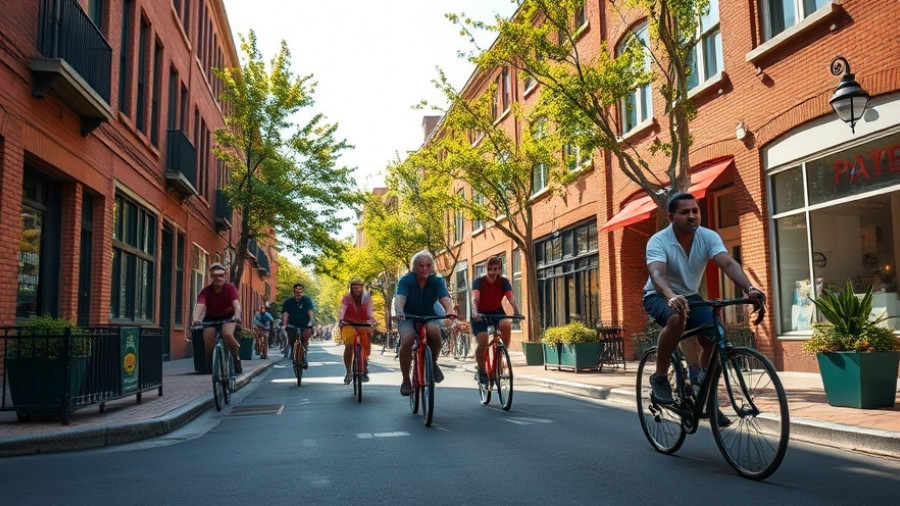
Creating Safe Spaces for Kids: London's Innovative School Street
In the bustling city of London, an inspiring transformation is taking place around one of the UK's largest cricket stadiums. London has ingeniously converted a roadway into a school street, creating a safe enclave that allows children to thrive in a play-centric environment. Rezina Chowdhury, a city council member from the borough of Lambeth, eloquently describes this initiative: "It gives children a place to be free and happy and playful." This conversion not only prioritizes the needs of young city dwellers but also enriches the community, making the space calm and inviting for all.
A Global Movement: What Are School Streets?
The concept of school streets is gaining traction worldwide, reflecting a growing awareness of children’s needs in urban planning. Initiated in Bolzano, Italy, in 1989, school streets emphasize safety by reducing vehicular traffic during critical times when students are entering and exiting schools. As reported in CityChangers.org, school streets encourage active mobility, thus promoting healthier lifestyles while increasing social interaction among children and community members alike. The strategy is adaptable, allowing cities to tailor approaches to their unique contexts and challenges.
Benefits of School Streets: More Than Just Safety
Research suggests that school streets yield substantial benefits beyond just safety. According to the Mums for Lungs campaign, implementing school streets can reduce car journeys to schools by 18% and air pollution by an impressive 26%. This transformation not only makes the environment safer for children but also enhances their ability to learn. Less noisy backgrounds contribute to improved focus and emotional wellness, equipping young minds for better academic success. These benefits extend to parents and the broader community, who can enjoy a more peaceful neighborhood.
Real-Life Applications: Mountain View vs. Westminster
Over in Westminster, London's Play Streets program has shown how local communities can unite to reclaim their streets. A recent launch at Northumberland Place attracted families eager to engage in activities away from traffic. The vibrant atmosphere allowed children to freely scoot and cycle while parents connected with each other, reinforcing community ties. Meanwhile, parents in Mountain View, California, might envision similar transformations in local neighborhoods, fostering spaces where culture, art, and wellness flourish.
Creating Kid-Friendly Zones: How Other Cities Can Follow Suit
The success of London's school streets model serves as a robust blueprint for other cities aiming to make their streets safer and friendlier for children. Civic engagement is paramount; community members can advocate for similar transformations by rising to local councils with proposals. Practical steps include initiating petitions for play streets or collaborating with local authorities to establish temporary barriers during school hours, ensuring the active participation of parents and children in the planning process.
Challenges on the Path to Transformation
Despite the clear benefits, implementing school streets isn’t without its challenges. Local governments may face budget constraints that make initial changes difficult. Skepticism about altering traffic patterns can also cause friction within communities. Yet, as history has shown, engaging the community effectively can overcome these hurdles. Demonstrative pilots, such as temporary play streets, can showcase potential benefits, shifting community perspectives toward acceptance and enthusiasm.
Looking Ahead: Future Predictions for Urban Planning
As urban planners and policymakers increasingly favor sustainability, initiatives like school streets are expected to flourish. With the continued focus on climate change and public health, cities that prioritize child-friendly spaces will likely see improved public health outcomes and community satisfaction. The proof is already evident in the changes transforming London and Westminster, and similar initiatives could soon blossom in the San Francisco Bay Area. Imagine walking your child to school on a calm and lively street, where neighbors gather in a shared space, celebrating their community!
It is time for residents of the Bay Area to draw inspiration from London's success stories. The benefits of transforming everyday streets into spaces where children can play freely and safely are simply too great to ignore. Join the conversation about creating a healthier, happier, and more connected community. By advocating for child-friendly zones and supporting local initiatives, we can foster environments where the spirit of play thrives and everyone has the chance to enjoy their streets.
 Add Row
Add Row  Add
Add 



Write A Comment